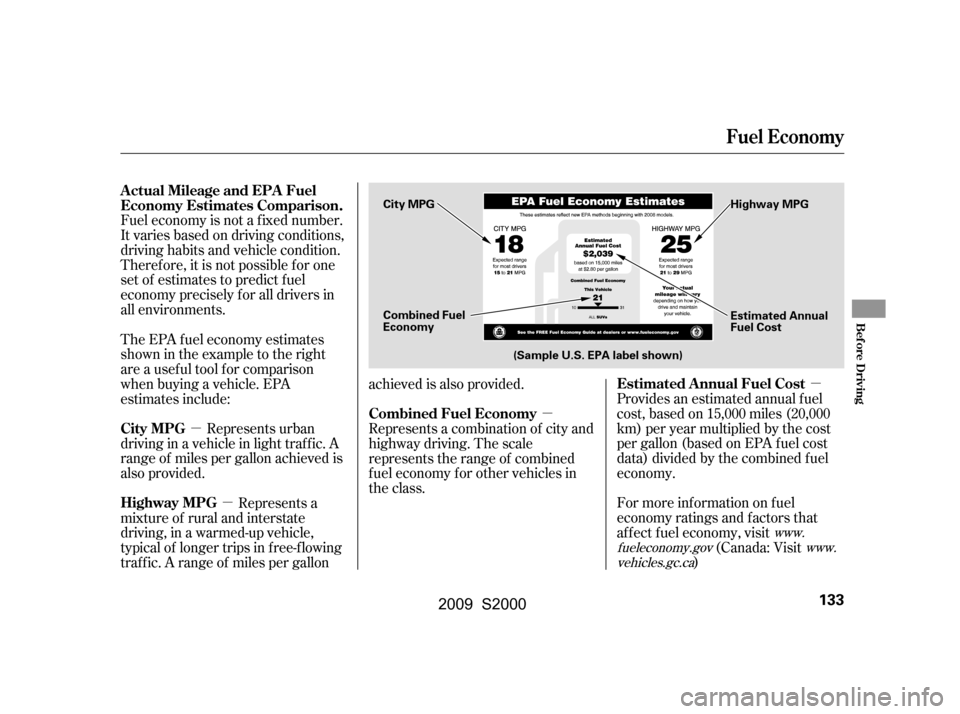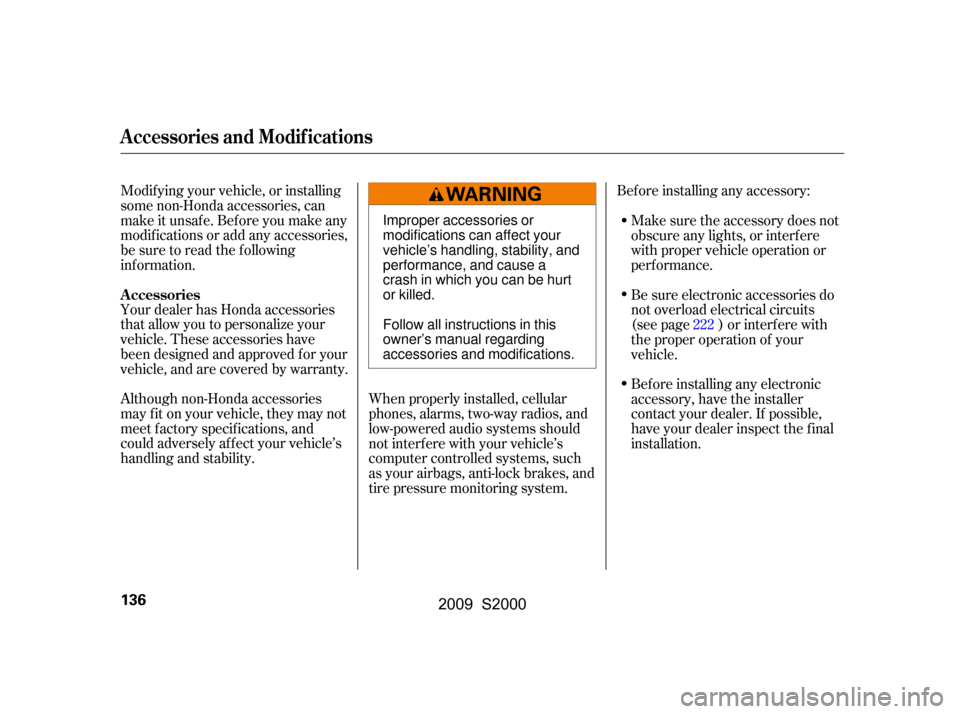Page 134 of 268
Remove the dipstick again, and
check the level. It should be
between the upper and lower
marks.
If it is near or below the lower mark,
see on page .
Wait a f ew minutes af ter turning the
engine of f bef ore you check the oil.
Remove the dipstick (black
handle).
Insert the dipstick all the way back
into its hole. Wipe of f the dipstick with a clean
cloth or paper towel.
To close the hood, lif t it up slightly to
remove the support rod f rom the
hole. Put the support rod back into
its holding clip. Lower the hood to
about a f oot (30 cm) above the
f ender, then let it drop. Make sure it
is securely latched. Holding the grip, pull the support
rod out of its clip. Insert the end
into the designated hole in the
hood.
3. 4.
1.
2.
3.
170
Service Station Procedures
A dding Engine Oil
Oil Check
Bef ore Driving
131
UPPER MARK
LOWER MARK
DIPSTICK
CLIP
SUPPORT ROD GRIP
2009 S2000
Page 136 of 268

�µ
�µ �µ
�µ
Fuel economy is not a f ixed number.
It varies based on driving conditions,
driving habits and vehicle condition.
Theref ore, it is not possible f or one
set of estimates to predict f uel
economy precisely f or all drivers in
all environments.
Provides an estimated annual f uel
cost, based on 15,000 miles (20,000
km) per year multiplied by the cost
pergallon(basedonEPAfuelcost
data) divided by the combined f uel
economy.
For more inf ormation on f uel
economy ratings and factors that
af f ect f uel economy, visit(Canada: Visit
)
Represents urban
driving in a vehicle in light traf f ic. A
range of miles per gallon achieved is
also provided.
The EPA f uel economy estimates
shownintheexampletotheright
are a usef ul tool f or comparison
when buying a vehicle. EPA
estimates include:
Represents a combination of city and
highway driving. The scale
represents the range of combined
f uel economy f or other vehicles in
the class.
Represents a
mixture of rural and interstate
driving, in a warmed-up vehicle,
typical of longer trips in f ree-f lowing
traf f ic. A range of miles per gallon achieved is also provided.
www.
fueleconomy.gov www.
vehicles.gc.ca
Actual Mileage and EPA Fuel
Economy Estimates Comparison.
Estimated Annual Fuel Cost
City MPG Combined Fuel Economy
Highway MPG
Fuel Economy
Bef ore Driving
133
Combined Fuel
Economy (Sample U.S. EPA label shown) Estimated Annual
Fuel Cost
City MPG
Highway MPG
2009 S2000
Page 139 of 268

Your dealer has Honda accessories
that allow you to personalize your
vehicle. These accessories have
been designed and approved f or your
vehicle, and are covered by warranty.Bef ore installing any accessory:
Although non-Honda accessories
may f it on your vehicle, they may not
meet f actory specif ications, and
could adversely af f ect your vehicle’s
handling and stability.
Modif ying your vehicle, or installing
some non-Honda accessories, can
make it unsaf e. Bef ore you make any
modif ications or add any accessories,
be sure to read the f ollowing
inf ormation. When properly installed, cellular
phones, alarms, two-way radios, and
low-powered audio systems should
not interf ere with your vehicle’s
computer controlled systems, such
as your airbags, anti-lock brakes, and
tire pressure monitoring system. Bef ore installing any electronic
accessory, have the installer
contact your dealer. If possible,
have your dealer inspect the f inal
installation.
Be sure electronic accessories do
not overload electrical circuits
(see page ) or interf ere with
the proper operation of your
vehicle.
Make sure the accessory does not
obscure any lights, or interf ere
with proper vehicle operation or
perf ormance.
222
A ccessories
A ccessories and Modif ications
136
Improper accessories or
modifications can affect your
vehicle’s handling, stability, and
performance, and cause a
crash in which you can be hurt
or killed.
Follow all instructions in this
owner’s manual regarding
accessories and modifications.
2009 S2000
Page 148 of 268
Youshoulddothefollowingchecks
and adjustments bef ore you drive
your vehicle.Make sure all windows, mirrors,
and outside lights are clean and
unobstructed. Remove f rost, snow,
or ice. Check that any items you may be
carrying are stored properly or
f astened down securely.
Fasten your seat belt. Check that
your passenger has f astened his or
her seat belt (see page ).
When you start the engine, check
the gauges and indicators in the
instrument panel (see page ).
Check the seat adjustment (see
page ).
Check the adjustment of the
inside and outside mirrors (see
page ).
Make sure the doors are securely
closed and locked.
Check that the hood is f ully closed.
Check that the trunk is f ully
closed.
Visually check the tires. If a tire
looks low, use a gauge to check its
pressure.
1.
2.
12
3.
4. 5.
6.
7.
8.
9.
10. 45
69
87
Preparing to Drive
Driving
145
2009 S2000
Page 152 of 268

Resting your f oot on the pedal keeps
the brakes applied lightly, builds up
heat, and reduces their ef f ectiveness
and reduces brake pad life. In
addition, f uel economy can be
reduced. It also keeps your brake
lights on all the time, conf using
drivers behind you.
Your vehicle is equipped with disc
brakes at all f our wheels. A power
assist helps reduce the ef f ort needed
on the brake pedal. The anti-lock
brake system (ABS) helps you retain
steering control when braking very
hard.
Always use the parking brake when
you park your vehicle. Make sure
the parking brake is set f irmly, or
your vehicle may roll if it is parked
on an incline.
Constant application of the brakes
when going down a long hill builds
up heat and reduces their ef f ective-
ness. Use the engine to assist the
brakes by taking your f oot of f the
accelerator and downshif ting to a
lower gear.
Make sure the convertible top and
the windows are closed.
Make sure the removable hardtop
is properly installed and the
windows are closed.
Make sure the parking brake is
f ully released bef ore driving away.
Driving with the parking brake
partially set can overheat or
damage the rear brakes.
If the vehicle is f acing downhill,
turn the front wheels toward the
curb, and put the transmission in
reverse gear.
If the vehicle is f acing uphill, turn
the front wheels away from the
curb, and put the transmission in
f irst gear.
Never park over dry leaves, tall
grass, or other f lammable materials. The hot three way
catalytic converter could cause
these materials to catch on fire.
Lock the doors.
Place any packages, valuables, etc.,
in the trunk or take them with you.
Turn of f the lights.
CONT INUED
Except CR models CR models
Parking
Parking T ips Braking System
Parking, Braking System
Driving
149
2009 S2000
Page 162 of 268

This section explains why it is
important to keep your vehicle well
maintained and how to f ollow basic
maintenance saf ety precautions.
If you have the skills and tools to
perf orm more complex maintenance
tasks on your vehicle, you may want
to purchase the service manual. See
page f or inf ormation on how to
obtain a copy, or see your dealer.
This section also includes
instructions on how to read the
maintenance minder messages on
the information display, and
instructions f or simple maintenance
tasks you may want to take care of
yourself .......................
Maintenance Saf ety .160
....................
Maintenance Minder .161
..............................
Fluid Locations .169
........................
Adding Engine Oil .170
.........
Changing the Oil and Filter .171
..............................
Engine Coolant .173
....................
Windshield Washers .175
........
Manual Transmission Fluid .176
..........................
Dif f erential Fluid .177
................
Brake and Clutch Fluid .178
.............................................
Lights .179
................
Cleaning the Seat Belts .184
.....................................
Floor Mats .185
..................
DustandPollenFilter .185
..............................
Audio Antenna .185
.................................
Wiper Blades .186
...........................................
Wheels .188
...............................................
Tires .188
...................
Checking the Battery .196
.............................
Vehicle Storage .198
251
Maintenance
Maint enance
159
2009 S2000
Page 170 of 268

�µ
�Ì �µ�µ�µ
�µ
U.S. Vehicles:
Youshouldcheckthefollowing
items at the specif ied intervals. If
you are unsure of how to perf orm
any check, turn to the appropriate
page listed. Lights Check the operation of
the headlights, parking lights,
taillights, high-mount brake light,
and license plate lights monthly.
See page .
According to state and federal
regulations, f ailure to perf orm
maintenance on the items marked
with will not void your emissions
warranties. However, all
maintenance services should be
perf ormed in accordance with the
intervals indicated by the
inf ormation display. Tires Check the tire pressure
monthly. Examine the tread f or
wear and foreign objects. See page.
Brakes and clutch Check the
f luid level monthly. See page .
Engine coolant level Check the
radiator reserve tank every time
youfillthefueltank.Seepage.
Engine oil level Check every
time you fill the fuel tank. See
page.
131
132
178
189 179
CONT INUED
Maintenance, replacement, or
repair of emissions control
devices and systems may be done
by any automotive repair
establishment or individual using
parts that are ‘‘certif ied’’ to EPA
standards.
Owner’s Maintenance Checks
Maintenance Minder
Maint enance
167
2009 S2000
Page 182 of 268

The low beam headlight bulbs are a
type of high voltage discharge tube.
High voltage can remain in the
circuit even with the light switch of f
and the key removed. Because of
this, you should not attempt to
examine or change a low beam
headlight bulb yourself . If a low
beam headlight bulb fails, take the
vehicle to your dealer to have it
replaced.Halogen bulbs are used f or the high
beam headlight bulbs. When
replacing a high beam headlight bulb,
handle it by its base, and protect the
glass from contact with your skin or
hard objects. If you touch the glass,
clean it with denatured alcohol and a
clean cloth.
Theheadlightswereproperlyaimed
when your vehicle was new. If you
regularly carry heavy items in the
trunk, readjustment may be required.
Adjustment should be done by your
dealer or other qualif ied mechanic.
CONT INUED
Headlight A iming
Replacing a Headlight Bulb
Lights
Maint enance
179
Halogen headlight bulbs get very hot
when lit. Oil, perspiration, or a scratch
on the glass can cause the bulb to
overheat and shatter.
2009 S2000